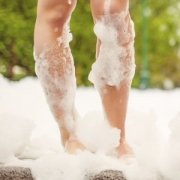Winter Woes For Toes
What is a Chilblain
A CHILBLAIN is an inflammatory condition caused by chilling and a drop in extremity temperature; an injury caused by cold, damp and wetness. It does not occur on cold, dry days.
When the body core temperature drops nature will attempt to preserve life. We can liver without fingers and toes, even arms and legs, and these will be sacrificed in order to support the centrally placed vital organs deep within the body.
Chilling of the extremities causes a state of paresis/paralysis of the tissue cell walls and blood capillary walls and this prevents a return to normality on artificial warming from an external heat source. The paresis prevents the normal transport of interstitial fluids through the cell walls and capillary walls by osmosis, diffusion and filtration. This is an important part of the reaction of the tissues to injury in inflammation. Hence the cells and tissue spaces around them fill with excess fluid and inflammation products which build up and cannot be readily dispersed by the bloodstream.
There are 4 stages that occur in the progression of chilblains:
CYANOTIC Chilling which is not felt by the patient and goes unnoticed.
HYPERAEMIC The patient will feel symptoms and is noticeable on examination. There will be a reddening of the skin followed by inflammation. The afflicted area is now bright red.
CONGESTIVE The affected areas are now red/purple and may itch due to the presence of the excess tissue fluid. The chilblain may resolve from this stage or could progress to the fourth stage. Depending on susceptibility of the patient and external conditions, the area may become tightly swollen and red/blue in colour.
ULCERATIVE This last stage may incur secondary infection of the broken ulcerated lesion. Chilblains that become injured, traumatically broken or ulcerated can take weeks to heal.
Chilblains are easily recognised on the end of toes as these areas may be red/purple or often purple with a red border. The ends of the toes may be distended with itching and burning.
Chilblains unfortunately respond quite poorly to treatment but applying warming creams from Autumn onward and throughout the Winter months with passive massage is helpful. Further advice can be obtained from Suzanne at 4Happy Feet, Plaza Mall, Dudley.
Written by Victor Fletcher DipBMec, DipCTec, FPSPract, Podiatrist (ret)






